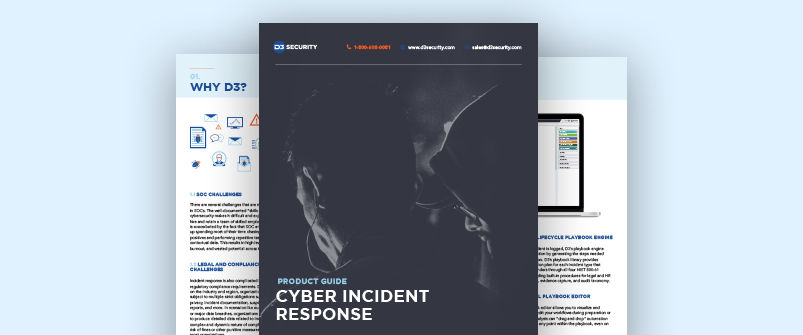

D3 has a truly unique cyber incident response offering, which makes it hard to classify—let alone do justice with a quick explanation. This is why we’ve written a comprehensive guide that takes you through the entire product journey. D3’s full-lifecycle capabilities are what sets it apart, so the product guide details the entire breadth of functionality, including:
- Detection in the SIEM and escalation to D3, via certified, two-way integrations;
- Automated incident record enrichment with contextual data from third-party sources;
- Incident response guided by NIST playbooks;
- Response orchestration in and outside of the SOC;
- Guided case management for deep investigations, collaboration, and link analysis;
- Root cause analysis and remediation; and
- Comprehensive reporting, detailed analytics, and compliance tools.
Since reading the product guide will give you an excellent sense of D3’s features, in this blog post, we’ll focus on some of the challenges we help our customers overcome. In our work with over 1000 organizations, these are some of the most common challenges we see, and D3 is the only incident response platform that can help you solve all of them from one unified platform.
Challenge #1: Not Enough Analysts, Not Enough Time
Talk to anyone who works in a SOC and they’ll tell you that there aren’t enough hours in the day for all the tasks they need to complete. On top of an already overwhelmed workforce, the growing cybersecurity skills gap is making it hard to find, hire, and retain qualified analysts.
D3 helps solve this problem with our automation features, which instantly complete tasks that used to eat up analysts’ time, such as enriching incident reports with contextual data from third party sources. Combined with D3’s ability to assign a risk score to every alert, based on your unique risk profile, D3 gives you back the countless hours your SOC team used to spend chasing after harmless false positives—a task that can take up as much as 67% of analysts’ time, according to a Ponemon Institute study from 2015.
Challenge #2: Going Beyond Triage
There are plenty of solutions on the market that will help you detect incidents, or even respond to simple one-off events. Even when done well, this is not a sustainable arrangement. Without deeper capabilities, you’ll always be reacting to the latest attack, or responding to the same incident types again and again.
D3 goes beyond triage with case management and post-incident investigation tools that help you understand the vulnerabilities that are leading to recurring threats. D3’s case management module enables you to bring related incidents together for deeper analysis and collaboration between investigators, while guided investigation templates ensure that even the most junior investigators are correctly following internal policies and industry best practices.
D3 goes even one step further, with workflows that include root cause analysis and corrective action. Treating the symptoms is one thing, but to make progress over time and reduce overall incident volume, you need to be able to find out why the incident happened and remediate any outstanding issues.
Challenge #3 Ensuring Compliance
Cybersecurity and data protection are top of mind for governments and regulators around the world. The risks have been vividly illustrated by high-profile cyber-attacks and data breaches, and the reaction has been to escalate compliance requirements and raise the potential fines. The upcoming GDPR alone will cause headaches in compliance departments around the world, with its high-stakes combination of far-reaching requirements and severe penalties.
D3 makes maintaining compliance fast and easy, within and outside of the security team. We offer turnkey solutions for common compliance reports such as SAR in the financial industry, breach notifications in healthcare, and NERC in energy, with built-in report templates that save time and minimize the risk of violations.
D3 also makes compliance reporting easier by acting as a centralized source and common taxonomy for all relevant data. When a regulator needs a report, or you’re in the middle of an audit, it’s a huge time-saver to not need to search across myriad data silos and file formats to collect the information you need.
D3 Cyber Incident Response Product Guide
If you can relate to the challenges we’ve described, or are looking to improve your organization’s resiliency and efficiency in the face of cybersecurity threats, be sure to download the complete product guide.
